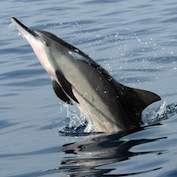Assessing threats to Hawai'i's spinner dolphins

(Phys.org) —Researchers have completed the most extensive study of the Hawai'i Island spinner dolphin population to date, with the data to be used to inform the local management agency.
Lead researcher Julian Tyne, from the Murdoch University Cetacean Research Unit, said there were concerns that human activities were having a negative impact on the dolphins.
"Hawai'i's spinner dolphins have a rigid daily routine, foraging for food in the open ocean at night and returning to sheltered bays to rest and socialise during the day," he said.
"These bays have seen a significant increase in tourist activity over the past 20 years, with a surge in dolphin watching boat tours and businesses offering the opportunity to interact with dolphins.
"It has previously been suggested that the dolphins are spending less time in the sheltered bays and that their rest is being interrupted, which may impact their ability to forage efficiently and spot predators."
The project is a collaboration between Murdoch University and Duke University (Durham, North Carolina). The National Oceanic and Atmospheric Administration (NOAA), the Marine Mammal Commission, Dolphin Quest and Murdoch University funded the research.
Researchers spent over two and a half years on Hawai'i Island, using modern visual and acoustic technology to collect baseline data.
"From the first year of our study, we estimated that there are 631 spinner dolphins among the Hawai'i Island associated stock, which is lower than any previous estimate, with a survival rate of 97 per cent," Mr Tyne said.
"These dolphins don't tend to mix with dolphins from other islands, meaning they are genetically more distinct.
"When this is combined with their rigid daily routine and ease of human access to the dolphins in their preferred resting habitats, they may be more vulnerable to negative impacts."
In 2006, the Government of Western Australia reduced the number of commercial boat tour licences operating in the Shark Bay / Monkey Mia region, following the results of a similar study into the region's bottlenose dolphins.
Mr Tyne said Hawaiian authorities were considering a number of strategies to help mitigate the impact of human interactions on the spinner dolphin population.
"Most people have good intentions and are excited at the idea of interacting with dolphins," he said.
"These interactions need to be managed to protect animals from harm, while ensuring the sustainability of wildlife tourism in Hawai'i."
More information: Tyne JA, Pollock KH, Johnston DW, Bejder L (2014) "Abundance and Survival Rates of the Hawai'i Island Associated Spinner Dolphin (Stenella longirostris) Stock." PLoS ONE 9(1): e86132. DOI: 10.1371/journal.pone.0086132
Journal information: PLoS ONE
Provided by Murdoch University



















